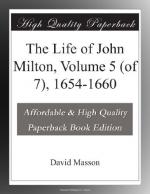[Footnote 1: Among authorities for the facts in this compilation, besides Council Order Books, and the whole narrative heretofore, are Carlyle’s three genealogical Notes (I. 16, 20-21, and 54-55), Wood’s Fasti, II. 155-8, various passages in Codwin, and two “Narratives” in Harl. Misc III. 429-468.]
The Protector’s new Privy Council for his Second Protectorate was not constituted till Monday, July 13, 1657, more than a fortnight after his installation. Then, his Highness being present, there were sworn in, according to the new oath of fidelity provided by the Petition and Advice, Lord President Lawrence, General Desborough, Lord Commissioner Fiennes, the Earl of Mulgrave, Lord Viscount Lisle, Mr. Rous, Lord Deputy Fleetwood, Lord Strickland, and Mr. Secretary Thurloe. This last took his seat at the board as full Councillor by special nomination of his Highness. In the course of the next few meetings there came in Colonel Sydenham, Major-General Skippon, Sir Gilbert Pickering, and Sir Charles Wolseley, raising the number to thirteen; which completed the Council for some time, though Colonel Philip Jones and Admiral Montague afterwards took their seats, and Lord Richard Cromwell, as we have seen, was added Dec. 31. On comparing the total list with that of the Council of the First Protectorate (Vol. IV. p. 545), it will be seen that Cromwell retained all that were alive of his former Council, except Lambert, Sir Anthony Ashley Cooper, and Mr. Richard Mayor. Sir Anthony Ashley Cooper had been a deserter from the former Council as early as Dec. 1654, and had since then been so conspicuous in the opposition that he had been one of the ninety-three excluded from the House at the opening of the Second Parliament. Mr. Mayor, Richard Cromwell’s father-in-law, though still nominally in the Council, seems to have been now in poor health and in retirement. The one extraordinary omission was that of Lambert. He had taken all but the chief part in the foundation of the First Protectorate;




